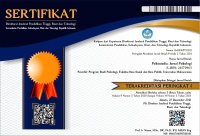Validity and Reliability of Anxiety Sensitivity Index-3 (ASI-3) Indonesian Version In Clinical and Non-Clinical Samples
Abstract
Anxiety Sensitivity refers to an individual’s fear of anxiety-related sensations. Anxiety Sensitivity Index-3 (ASI-3) is the latest instrument used to measure anxiety sensitivity. So far, there hasn't been any investigation into the psychometric qualities of the Indonesian version of ASI-3. The aims of this rsearch is to to explore the psychometric characteristics of the ASI-3 instrument in Indonesian. Participants in this research were 264 individuals aged 18–54 years (M=23.86, SD=4.61) in Indonesia recruited through convenience sampling. The outcomes of the psychometric assessment using Confirmatory Factor Analysis (CFA), tests for construct validity, and Cronbach’s Alpha coefficient, indicated strong validity and reliability of the ASI-3. This study found the Indonesian version of ASI-3 has a similar theoretical model to the English version. Concluded that the Indonesian version of ASI-3 is a reliable instrument can be used as an adequate measure of anxiety sensitivity in Indonesia. The Indonesian version of ASI-3 can differentiate scores between individuals with and without psychological disorders.
Sensitivitas Kecemasan (Anxiety Sensitivity) merupakan rasa takut individu akan sensasi yang timbul terkait kecemasan. Anxiety Sensitivity Index-3 (ASI-3) merupakan alat ukur baru yang digunakan untuk menilai sensitivitas kecemasan, namun belum ada riset yang mengkaji kualitas psikometrik adaptasi alat ukur dan uji psikomerik ASI-3 bahasa Indonesia. Penelitian ini bertujuan untuk mengeksplorasi karakteristik psikometrik instrumen ASI-3 dalam bahasa Indonesia. Partisipan penelitian ini adalah 262 individu berusia 18–54 tahun (M=23.86, SD=4.61) di Indonesia yang dikumpulkan dengan convenience sampling. Hasil evaluasi psikometrik menggunakan analisis faktor konfirmatori (CFA), uji validitas konstruk, dan penghitungan Cronbach’s Alpha menunjukkan bahwa ASI-3 menunjukkan tingkat validitas dan reliabilitas yang signifikan, serta mengadopsi model teoretis yang serupa dengan versi bahasa Inggrisnya. Penelitian ini menyimpulkan bahwa ASI-3 layak digunakan sebagai alat ukur yang efektif untuk menilai tingkat sensitivitas terhadap kecemasan di Indonesia. ASI-3 versi bahasa Indonesia dapat membedakan skor antara individu dengan gangguan psikologis dan individu tanpa gangguan psikologis.
Keywords
Full Text:
FULL TEXTReferences
Azwar, S. (2012). Reliabilitas dan Validitas (Edisi 4). Putaka pelajar.
Bienvenu, O. J., & Ginsburg, G. S. (2007). Prevention of anxiety disorders. International Review of Psychiatry, 19(6), 647–654. https://doi.org/10.1080/09540260701797837
Brown, T. A. (2015). Confirmatory Factor Analysis for Applied Research. In The American Statistician (Vol. 62, Issue 1). The Guilford Press. https://doi.org/10.1198/tas.2008.s98
Brown, T. A., & Moore, M. T. (2012). Handbook of structural equation modeling: Confirmatory factor analysis. https://www.researchgate.net/publication/251573889_Hoyle_CFA_Chapter_-_Final
Cai, W., Dong, W., Pan, Y., Wei, C., Zhang, S., Tian, B., Yan, J., & Deng, G. (2018). Reliability, validation and norms of the Chinese version of Anxiety Sensitivity Index 3 in a sample of military personnel. PLOS ONE, 13(8), e0201778. https://doi.org/10.1371/JOURNAL.PONE.0201778
Cangur, S., & Ercan, I. (2015). Comparison of model fit indices used in structural equation modeling under multivariate normality. Journal of Modern Applied Statistical Methods, 14(1), 152–167. https://doi.org/10.22237/JMASM/1430453580
ÇELİK, E., BİÇENER, E., & MAKAS, S. (2023). Relationship between Anxiety Sensitivity, Death Anxiety, and Resilience in the Age of Pandemics and Lifelong Learning. International Journal of Educational Research Review, 8(2), 289–302. https://doi.org/10.24331/ijere.1246833
Creighton, A. S., Davison, T. E., & Kissane, D. W. (2018). The assessment of anxiety in aged care residents: a systematic review of the psychometric properties of commonly used measures. International Psychogeriatrics, 30(7), 967–979. https://doi.org/10.1017/S1041610217002599
Dennis, R. E., Boddington, S. J. A., & Funnell, N. J. (2007). Self-report measures of anxiety: Are they suitable for older adults? Aging & Mental Health, 11(6), 668–677. https://doi.org/10.1080/13607860701529916
Ebell, Robert L. & Friesbie, D. A. (1991). Essentials of Educational Measurement. Journal of Educational Measurement, fifth edit, 1–383. https://ebookppsunp.files.wordpress.com/2016/06/robert_l-ebel_david_a-_frisbie_essentials_of_edbookfi-org.pdf
Edelman, R. J. (1992). Anxiety theory research and intervention in clinical and health psychology. Clinical Psychology and Psychotherapy (An International Journal of Theory & Practice), 1(1), 62–62. https://doi.org/10.1002/cpp.5640010111
Erskine, H. E., Blondell, S. J., Enright, M. E., Shadid, J., Wado, Y. D., Wekesah, F. M., Wahdi, A. E., Wilopo, S. A., Vu, L. M., Dao, H. T. K., Nguyen, V. D., Emerson, M. R., Fine, S. L., Li, M., Blum, R. W.,
Whiteford, H. A., & Scott, J. G. (2023). Measuring the Prevalence of Mental Disorders in Adolescents in Kenya, Indonesia, and Vietnam: Study Protocol for the National Adolescent Mental Health Surveys. Journal of Adolescent Health, 72(1), S71–S78. https://doi.org/10.1016/J.JADOHEALTH.2021.05.012
Fitzgerald, H. E., Hoyt, D. L., Kredlow, M. A., Smits, J. A. J., Schmidt, N. B., Edmondson, D., & Otto, M. W. (2021). Anxiety Sensitivity as a Malleable Mechanistic Target for Prevention Interventions: A Meta-Analysis of the Efficacy of Brief Treatment Interventions. Clinical Psychology : A Publication of the Division of Clinical Psychology of the American Psychological Association, 28(4), 323–337. https://doi.org/10.1037/CPS0000038
Goodwin, R. D., Weinberger, A. H., Kim, J. H., Wu, M., & Galea, S. (2020). Trends in anxiety among adults in the United States, 2008–2018: Rapid increases among young adults. Journal of Psychiatric Research, 130, 441–446. https://doi.org/10.1016/J.JPSYCHIRES.2020.08.014
Hayya, R. N., & Savitri, L. S. Y. (2023). Assertive Communication Skills Group Intervention for Adolescents with Social Anxiety. Psikostudia : Jurnal Psikologi, 12(3), 401. https://doi.org/10.30872/psikostudia.v12i3.11264
Hjeltnes, A., Molde, H., Schanche, E., Vøllestad, J., Lillebostad Svendsen, J., Moltu, C., & Binder, P. E. (2017). An open trial of mindfulness-based stress reduction for young adults with social anxiety disorder. Scandinavian Journal of Psychology, 58(1), 80–90. https://doi.org/10.1111/SJOP.12342
International Test Comission. (2017). Guidelines for Translating and Adapting Tests. International Test Commission (ITC), 1–5. http://scholar.google.com/scholar?hl=en&btnG=Search&q=intitle:International+Test+Commission+Guidelines+for+Translating+and+Adapting+Tests#0
Kaplan, R., & Saccuzzo, D. (2005). Psychological Testing: Principles, Applications, and Issues (6th editio). Wadsworth.
Lubis, H., Rosyida, A. H., Wulandari, F., & Sandya, S. N. (2017). Connecting Group Activity Dalam Menurunkan Kecemasan Sosial Pada Gen-Z. Psikostudia : Jurnal Psikologi, 6(1), 1. https://doi.org/10.30872/psikostudia.v6i1.2357
Meier, S. M., Mattheisen, M., Mors, O., Mortensen, P. B., Laursen, T. M., & Penninx, B. W. (2016). Increased mortality among people with anxiety disorders: Total population study. British Journal of Psychiatry, 209(3), 216–221. https://doi.org/10.1192/bjp.bp.115.171975
Mental Health Foundation. (2016). Fundamental facts about mental health. Fundamental Facts About Mental Health 2016, 89. https://www.mentalhealth.org.uk/sites/default/files/fundamental-facts-about-mental-health-2016.pdf
Mughal, A. Y., Devadas, J., Ardman, E., Levis, B., Levis, B., Go, V. F., & Gaynes, B. N. (2020). A systematic review of validated screening tools for anxiety disorders and PTSD in low to middle income countries. BMC Psychiatry, 20(1), 1–18. https://doi.org/10.1186/S12888-020-02753-3/TABLES/5
Naragon-Gainey, K. (2010). Meta-Analysis of the Relations of Anxiety Sensitivity to the Depressive and Anxiety Disorders. Psychological Bulletin, 136(1), 128–150. https://doi.org/10.1037/A0018055
Oktaviani, M. A., Rahmi, A. S., Khatimah, H., Nur, M., & Lubis, H. (2016). Musik Kejien Dalam Menurunkan Tingkat Kecemasan, Stres, dan Depresi. Psikostudia: Jurnal Psikologi, 5(1). http://e-journals.unmul.ac.id/index.php/PSIKO/article/view/2279
Osman, A., Gutierrez, P. M., Smith, K., Fang, Q., Lozano, G., & Devine, A. (2010). The anxiety sensitivity index-3: Analyses of dimensions, reliability estimates, and correlates in nonclinical samples. Journal of Personality Assessment, 92(1), 45–52. https://doi.org/10.1080/00223890903379332
Peterson, C. H., Peterson, N. A., & Powell, K. G. (2017). Cognitive interviewing for item development: Validity evidence based on content and response processes. In Measurement and Evaluation in Counseling and Development (Vol. 50, Issue 4, pp. 217–223). https://doi.org/10.1080/07481756.2017.1339564
Rapee, R. M., Kennedy, S., Ingram, M., Edwards, S., & Sweeney, L. (2005). Prevention and early intervention of anxiety disorders in inhibited preschool children. Journal of Consulting and Clinical Psychology, 73(3), 488–497. https://doi.org/10.1037/0022-006X.73.3.488
Reiss, S. (1991). Expectancy model of fear, anxiety, and panic. Clinical Psychology Review, 11(2), 141–153. https://doi.org/10.1016/0272-7358(91)90092-9
Reiss, S., Peterson, R. A., Gursky, D. M., & McNally, R. J. (1986). Anxiety sensitivity, anxiety frequency and the prediction of fearfulness. Behaviour Research and Therapy, 24(1), 1–8. https://doi.org/10.1016/0005-7967(86)90143-9
Saviola, F., Pappaianni, E., Monti, A., Grecucci, A., Jovicich, J., & De Pisapia, N. (2020). Trait and state anxiety are mapped differently in the human brain. Scientific Reports, 10(1). https://doi.org/10.1038/S41598-020-68008-Z
Schumacker, R. E., & Lomax, R. G. (2010). A Beginner’s Guide to Structural Equation Modeling. In Journal of the Royal Statistical Society Series A: Statistics in Society (3rs editio, Vol. 175, Issue 3). Taylor & Francis Group. https://doi.org/10.1111/j.1467-985x.2012.01045_12.x
Sulistiawan, A., Sari, E. Y. D., & Situmorang, N. Z. (2021). Validitas dan Reliabilitas Konstruk Komitmen Organisasi dengan Pendekatan Confirmatory Factor Analysis (CFA). Psikostudia : Jurnal Psikologi, 10(1), 61. https://doi.org/10.30872/psikostudia.v10i1.5478
Taylor, S., & Cox, B. J. (1998). An expanded anxiety sensitivity index: Evidence for a hierarchic structure in a clinical sample. Journal of Anxiety Disorders, 12(5), 463–483. https://doi.org/10.1016/S0887-6185(98)00028-0
Taylor, S., Zvolensky, M. J., Cox, B. J., Deacon, B., Heimberg, R. G., Ledley, D. R., Abramowitz, J. S., Holaway, R. M., Sandin, B., Stewart, S. H., Coles, M., Eng, W., Daly, E. S., Arrindell, W. A., Bouvard, M., & Cardenas, S. J. (2007). Robust Dimensions of Anxiety Sensitivity: Development and Initial Validation of the Anxiety Sensitivity Index-3. Psychological Assessment, 19(2), 176–188. https://doi.org/10.1037/1040-3590.19.2.176
Therrien, Z., & Hunsley, J. (2012). Assessment of anxiety in older adults: A systematic review of commonly used measures. Aging & Mental Health, 16(1), 1–16. https://doi.org/10.1080/13607863.2011.602960
Twenge, J. M. (2000). The age of anxiety? birth cohort change in anxiety and Neuroticism, 1952-1993. Journal of Personality and Social Psychology, 79(6), 1007–1021. https://doi.org/10.1037/0022-3514.79.6.1007
Warren, ann marie, Zolfaghari, K., Fresnedo, M., Bennett, M., Pogue, J., Waddimba, A., Zvolensky, M., Carlbring, P., & Powers, mark b. (2021). Anxiety sensitivity, COVID-19 fear, and mental health: results from a United States population sample. Routledge.
Wheaton, M. G., Mahaffey, B., Timpano, K. R., Berman, N. C., & Abramowitz, J. S. (2012). The relationship between anxiety sensitivity and obsessive-compulsive symptom dimensions. Journal of Behavior Therapy and Experimental Psychiatry, 43(3), 891–896. https://doi.org/10.1016/J.JBTEP.2012.01.001
WHO. (2000). Mental health and work: Impact, issues and good practices.
WHO. (2017). Depression and other common mental disorders 2017. http://apps.who.int/iri
Willis, G. (2011). Cognitive Interviewing: A “How To” Guide. Cognitive Interviewing. https://doi.org/10.4135/9781412983655
DOI: http://dx.doi.org/10.30872/psikostudia.v13i2.15249
Refbacks
- There are currently no refbacks.
Copyright (c) 2024 Fathiya Aisha Sadf & Hery Susanto

This work is licensed under a Creative Commons Attribution-ShareAlike 4.0 International License.
Psikostudia: Jurnal Psikologi is indexed by :
PSIKOSTUDIA: Jurnal Psikologi Published by Faculty of Social and Political Siences, University of Mulawarman, Samarinda, East Kalimantan and This work is licensed under a Creative Commons Attribution-ShareAlike 4.0 International License.
_________________________________________
PSIKOSTUDIA: Jurnal Psikologi
Department of Psychology
Faculty of Social and Political Siences, University of Mulawarman
Jl. Muara Muntai Kampus Gn. Kelua Samarinda 75411
Phone: +62 813 35350368
E-Mail: psikostudia@fisip.unmul.ac.id




















